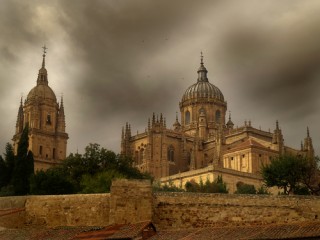
Jose Benito De Churriguera biography
Date of birth : 1665-03-21
Date of death : 1725-03-02
Birthplace : Madrid, Spain
Nationality : Spanish
Category : Arhitecture and Engineering
Last modified : 2011-08-10
Credited as : Architect, Cathedral of Salamanca, Baroque style
Jose Benito de Churriguera (1665-1725) was a Spanish architect and sculptor in the late baroque style. His artistic expression fused, with elaborate theatricality, the influences of Spain's late Renaissance style and that of the Roman baroque.
Until recently both Salamanca and Barcelona were cited as the probable birthplace of Jose Benito de Churriguera, but it is now known that he was born and died in Madrid. His obituary hailed him as "the Spanish Michelangelo," and his death occurred just in time for him to escape knowing the hysterically adverse criticism hurled at his works by the neoclassicists, who coined the term "Churrigueresque" to signify an accursed style of excess and extravagance. Ironically, these academicians sometimes praised works by him, believing them to have had other authors.
Jose Benito was one of a family of artists, of which he became the head after the death of his father, Jose Simonde Churriguera, in 1679. Jose Benito's brothers were Joaquin, Alberto, Manuel, and Miguel. Of the works of the three sons of Jose Benito—Matias, Jeronimo, and Nicolas, all architects—very little is known, no doubt because they were trained in a style rejected by their generation.
King Charles II named Jose Benito an architect for the royal works in 1690, although he did not begin to receive a salary for this office until 1696. In 1702 Teodoro Ardemans was named chief architect by King Philip V, and shortly thereafter Churriguera was accused of insubordination and presumption. The loss of royal patronage was balanced by the acquisition of a private patron, the banker Juan de Goyeneche. In addition, Churriguera had become the architect of Salamanca Cathedral in 1690. Although he worked almost exclusively in Madrid during the last 26 years of his life, his Salamanca appointment proved an "open sesame" to important commissions for his brothers and at least one of his sons.
Churriguera first attracted fame when he won the competition for the catafalque for Charles II's first queen, Maria Luisa d'Orleans. This temporary monument was erected in the Church of the Encarnacion, Madrid, and a sketch of it was published. His most famous altarpiece is that in the church of S. Esteban, Salamanca (1693). It is an architectural frame for sculptures, carved and gilded, with projections and recessions in monumental proportions and featuring Solomonic (twisted) columns. Despite the lavish ornament, the altarpiece has an impressive dignity achieved by rhythmic unity and harmonious proportions.
The most original architectural work by Churriguera is his urban layout for a new town, Nuevo Baztan, near Madrid. It was commissioned by Goyeneche to include a glass factory, workers' dwellings, a church, and a palace in a complex with three plazas. Its architectural austerity is reminiscent of the work of Juan de Herrera, and its asymmetry is unique as well as visually effective.
















